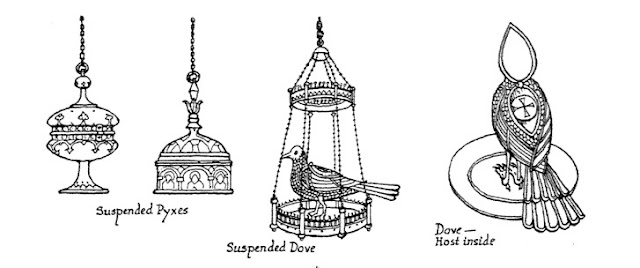Continuing on with our considerations of historical modes of reserving the Eucharist, in a previous artcile we considered the sacrament tower and today we turn our attention to the hanging pyx. The hanging pyx is a suspended form of tabernacle for the Blessed Sacrament. Archdale King in Eucharistic Reservation in the Western Church suggests that it was a "very general" (though not universal) form of Eucharistic reservation throughout England, Scotland and France during the middle ages -- and in France, later still according to Peter F. Anson.
Of its characteristics, ornamentation and function, King has this to say:
Of its characteristics, ornamentation and function, King has this to say:
The usual method for fixing the pyx was for a crane or pulley to be so arranged over the altar as to permit of the ready raising or lowering of the pyx, which was suspended by a cord or chain attached to a ring on its top. Above the pyx was hung the canopy, a circular tent-like construction formed of some costly fabric, which was generally attached to a ring and ornamental crown of metal. The pyx itself was veiled in a pyx cloth, which often had the form of a square napkin, with a hole in the middle, through which the suspending cord passed, and weighted tassles at the four corners which kept it down close by the pyx.One extant mediaeval example of the pyx cloth that covered the pyx cab be found in the Hessett Church in Suffolk, England:
A more contemporary example can be seen here:






















